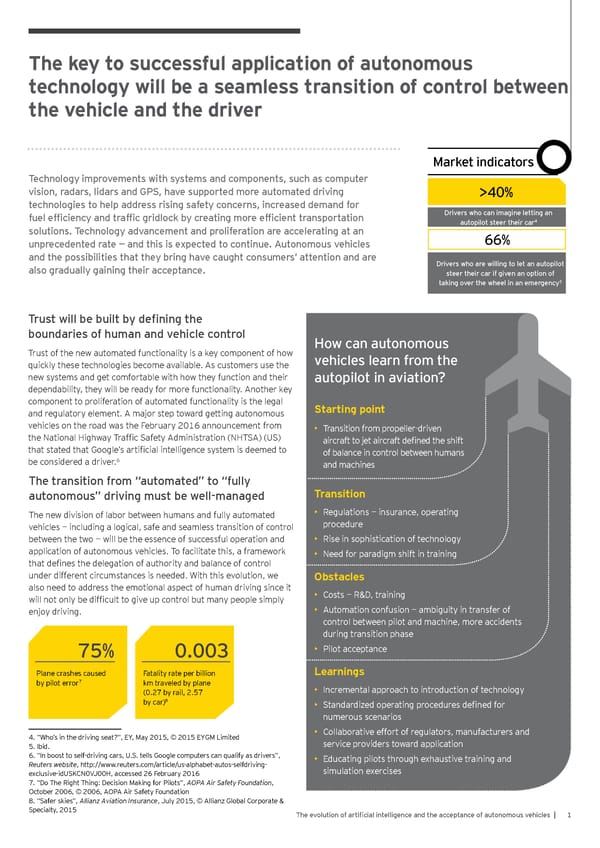T h e k e y t o s u c c e s s f u l a p p l ic a t i o n o f a u t o n o m o u s t e c h n o lo g y w i l l b e a s e a m le s s t r a n s i t i o n o f c o n t r o l b e t w e e n t h e v e h ic le a n d t h e d r i v e r Market indicators Technology improvements with systems and components, such as computer vision, radars, lidars and GPS, have supported more automated driving >40% technologies to help address rising safety concerns, increased demand for fuel efficiencq and traffic gridlocc Zq creating more efficient transportation Drivers who can imagine letting an 4 solutions. Technology advancement and proliferation are accelerating at an autopilot steer their car unprecedented rate — and this is expected to continue. Autonomous vehicles 66% and the possibilities that they bring have caught consumers’ attention and are Drivers who are willing to let an autopilot also gradually gaining their acceptance. steer their car if given an option of taking over the wheel in an emergency5 Trust oill Ze Zuilt Zq defining the boundaries of human and vehicle control How can autonomous Trust of the new automated functionality is a key component of how vehicles learn from the quickly these technologies become available. As customers use the new systems and get comfortable with how they function and their autopilot in aviation? dependability, they will be ready for more functionality. Another key component to proliferation of automated functionality is the legal S t a rt in g p oin t and regulatory element. A major step toward getting autonomous vehicles on the road was the February 2016 announcement from • Transition from propeller-driven the National Highway Traffic Safety Administration (NHTSA) (US) aircraft to jet aircraft defined the shift that stated that Google’s artificial intelligence system is deemed to of balance in control between humans 6 be considered a driver. and machines The transition from “automated” to “fully autonomous” driving must be well-managed T ra n s it ion The new division of labor between humans and fully automated • Regulations — insurance, operating vehicles — including a logical, safe and seamless transition of control procedure between the two — will be the essence of successful operation and • Rise in sophistication of technology application of autonomous vehicles. To facilitate this, a framework • Need for paradigm shift in training that defines the delegation of authority and balance of control under different circumstances is needed. With this evolution, we O b st a c les also need to address the emotional aspect of human driving since it • Costs — R&D, training will not only be difficult to give up control but many people simply enjoy driving. • Automation confusion — ambiguity in transfer of control between pilot and machine, more accidents during transition phase 75% 0.003 • Pilot acceptance Plane crashes caused Fatality rate per billion L e a rn in g s 7 by pilot error km traveled by plane • Incremental approach to introduction of technology (0.27 by rail, 2.57 8 by car) • Standardized operating procedures defined for numerous scenarios 4. “Who’s in the driving seat?”, EY, May 2015, © 2015 EYGM Limited • Collaborative effort of regulators, manufacturers and 5. Ibid. service providers toward application 6. “In boost to self-driving cars, U.S. tells Google computers can qualify as drivers”, • Educating pilots through exhaustive training and Reuters website, http://www.reuters.com/article/us-alphabet-autos-selfdriving- simulation exercises exclusive-idUSKCN0VJ00H, accessed 26 February 2016 7. “Do The Right Thing: Decision Making for Pilots”, AOPA Air Safety Foundation, October 2006, © 2006, AOPA Air Safety Foundation 8. “Safer skies”, Allianz Aviation Insurance, July 2015, © Allianz Global Corporate & Specialty, 2015 The evolution of artificial intelligence and the acceptance of autonomous vehicles | 1
 How much Human do we Need in a Car? Page 2 Page 4
How much Human do we Need in a Car? Page 2 Page 4